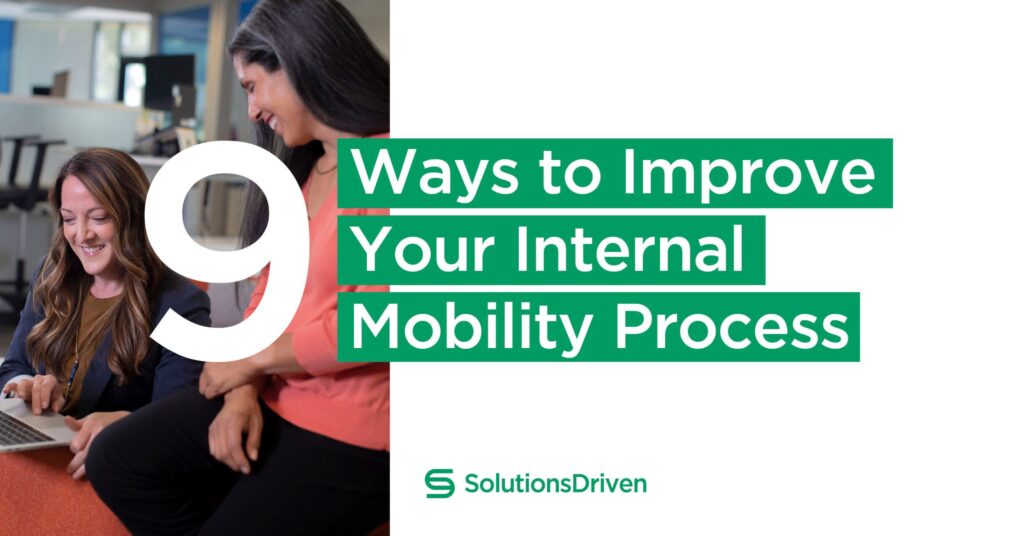
“The benefits of internal mobility has come up in many conversations I’ve had recently.
Senior management aren’t out and about meeting new people as much, and remote interviews are becoming more commonplace.
Many businesses have got leaner or grown with less than they ever have in the past. This has pushed companies to look at the talent they have, rather than automatically looking outside their company.
Business Needs Are Changing
Traditionally, hiring managers contacted us if they had a role to fill, particularly a senior one. Now, businesses want us to search for outside candidates, benchmark against internal teams, and identify suitable existing employees.
| Instead of just bringing in recruiters, clients now need help from a business that acts as an extension of their team. While their own Talent Team work on internal roles and employee development, they require more help with external candidates. Companies are increasingly unearthing hidden staffing gems and realising internal mobility is a valuable area they’ve overlooked. But a great internal mobility program isn’t something that can be done (well) in a couple of months, and there can be setbacks along the way. |
What is “Internal Mobility”?
Internal mobility describes the horizontal and vertical talent mobility within an organisation.
If done properly, a good internal mobility program makes employees engage with the company, and learn new skills to help their career and the business.
It also improves employee retention rates, and helping to identify recruitment gaps so companies can plan ahead and hire their dream employee.
Where Current Issues Lie…
Companies Accept and Embrace Job-Hopping
If we go back a couple of generations, people stayed in the same company for most of their lives. But as the proportion of millennials rose in the workforce, so did job hopping.

By 2016, publications like Forbes were proponents of job-hopping with article titles like “Millennials, Stop Apologising For Job-Hopping”. In 2017, the BBC featured a report on how the average UK worker will change employer every five years.
Employers began to see job hopping as normal. Instead of helping to enable internal mobility to improve high turnover, they accepted talent mobility as a fact of doing business.
Company Cultures Create Clashes
If every department works separately, vying for their own success, your internal mobility program becomes an issue, dominated by push and pull between teams and managers. Managers don’t want to lose good team members and hiring managers don’t want to take their peers’ good performers.
In this type of culture, employees don’t get the chance to move out of their current department or up the ladder, so they’re more likely to leave to get the job moves they want.
Hiring Managers Don’t Look Far Enough Ahead
When hiring managers come to us with a role, they usually have a specific list of required skills and qualifications. But looking for growth ability is less common.
| In January 2020, The World Economic Forum predicted 50% of jobs would be transformed by 2030 (and it’s likely more now). That means workforces now and in the future will need to be flexible, adaptable, and have the ability to learn new skills. |
When hiring managers go straight to a list of skills and qualifications, they’ve often overlooked people in their team with the capacity for learning who are ideal candidates to move up in the business.
Businesses Don’t Know Who Their Top Talent is
Without knowing who the best people in your business are, it’s difficult to know who to hold on to, and where there are skills gaps. Managers don’t encourage employees to upskill efficiently, making it hard to quickly identify the best fit for a role.
Companies lose key employees and spend time hiring for roles unnecessarily, rather than filling roles externally that can advance their business.
The Benefits of a Good Internal Mobility Process
Let’s start with some stats on external hiring to give some context:
– It costs approximately £3000 on average to hire a new member of staff.
– According to Hays, it takes 3-6 months for new employees to settle in.
– For a period, external hires can perform worse than existing employees.
– It’s immediately obvious which roles can be filled internally and which need an external recruitment search.
In addition you get stronger employee engagement, talent acquisition teams have a better view of their overall pipeline, and can keep on track of internal mobility best practices.
But it’s not just that internal hires are cheaper and quicker to make, there are many ways internal mobility can benefit your business…
Boost Employee Retention Through A Strong Internal Mobility Strategy
By hiring internal candidates, existing talent is less likely to leave because they can see where career advancement comes from. High employee retention rates for internal employees have a host of benefits for businesses; reduced costs, more productivity, improved customer experience, and better employee morale.
One of the main reasons employees give for leaving a company is not enough career progression or opportunities.
The Importance of Career Development for Internal Talent
A 2019 report by Employee Benefits found career development is the main reason why employees leave their jobs. “Lack of growth and development opportunities” come a close second. Professional growth is important to today’s workers.
Additionally, a high turnover can affect your Candidate Value Proposition, making your business unattractive to outside candidates. By keeping your existing employees happy and in your company, it makes outside hiring when it’s needed easier.
Employees Continually Learn in a Good Internal Mobility Program

If companies use internal mobility strategies effectively, internal talent continually learns and develops within the business, and retaining talent becomes easier. Taking knowledge from one level or department to another helps share information across silos.
And employees continually work on their development to further their careers. This focus helps the overall knowledge within the organisation, and helps it to grow and innovate, helping your employer brand.
The Benefits to Employees
Potential candidates can see that you’re invested in internal recruiting and that by joining the company, they’ll get the benefits of career mobility and the professional development that comes with it.
Departmental Cooperation Improves
There are always issues in siloed companies, from power struggles between department heads, to duplicated work, and unengaged teams.
Without Communication, Siloes Form
However, if employee movement becomes normal, departmental cooperation improves. Team members bring insights into how other departments work, share their knowledge, and open up paths between teams.
Executives moving to management positions help the senior team understand the struggles of an average employee, and bring fresh perspectives.
Companies Get Better Leadership
When upwards internal mobility is standard practise, more leaders know how the whole business operates. Working at and understanding every level fosters empathy and understanding of functionality among internal talent.
It can also assist with getting respect and authority from experienced team members, particularly if the hiring process is done in a fair way, and people are provided with their own clear progression plans.
Your EVP Improves, So Your CVP Improves
If your employees are happy in their roles because of a strong internal mobility program and feel like career progression is available, they’ll discuss it with their family and friends. All of whom are potential employees.
Less unhappy people leaving your company means less negative reviews online, and more champions to spread the word of how great it is to work for you.
When your employer brand improves, your candidate brand improves too.
But what’s a recruitment company doing extolling the benefits of promoting internal candidates?
We believe the job of recruitment companies isn’t to get someone into a role. It’s to get the right person into the right role, and for them to stay there long-term. And a good internal mobility program is part of this.
People will still leave businesses for a myriad of reasons. But with great internal mobility strategies businesses have a progression strategy and a plan for filling the position. They’ll know when they can fill a role, and when to bring in outside help. Internal talent acquisition teams can work on up-skilling and talent mapping, only bringing in external talent teams when they’re really needed.






